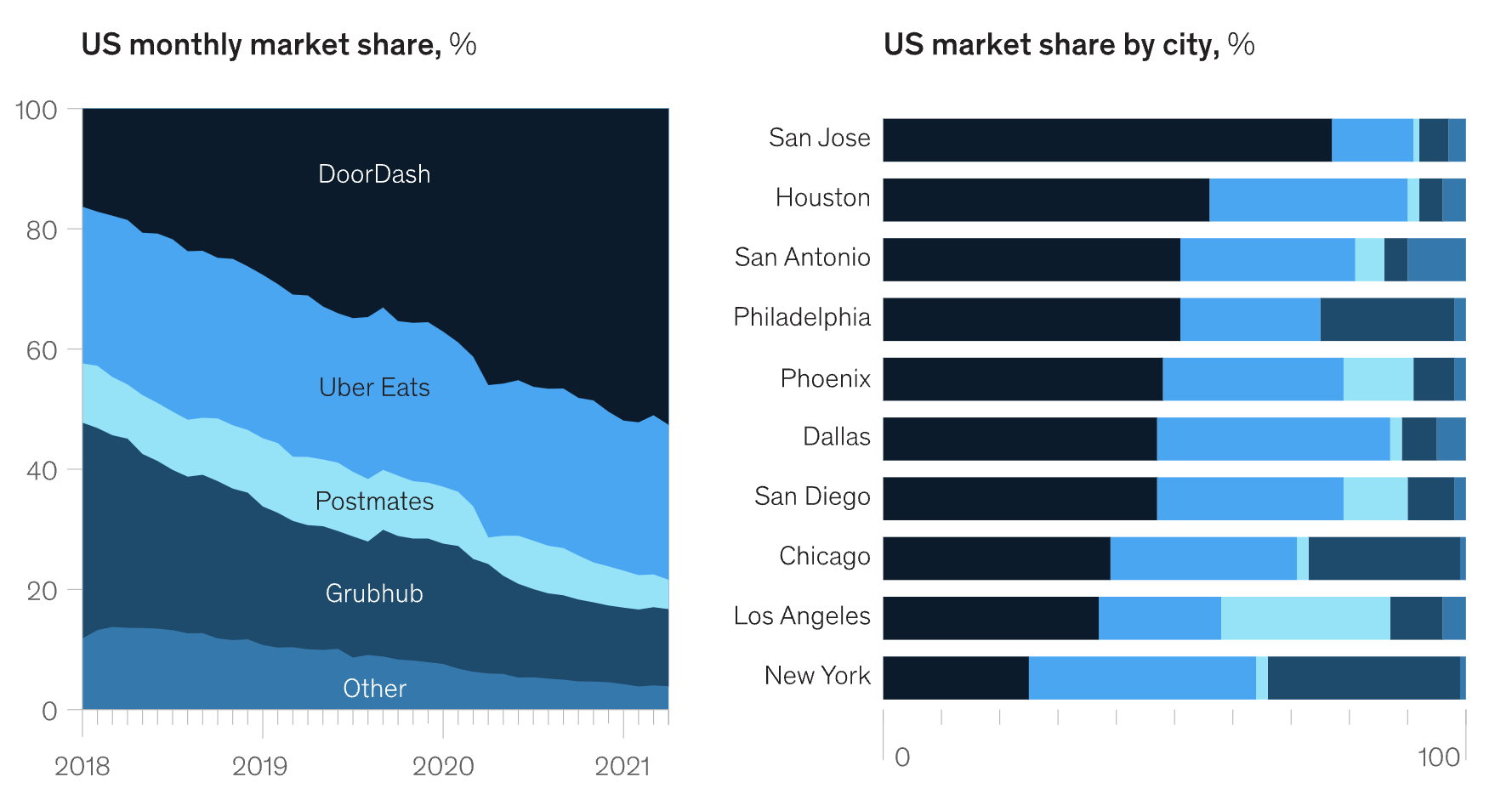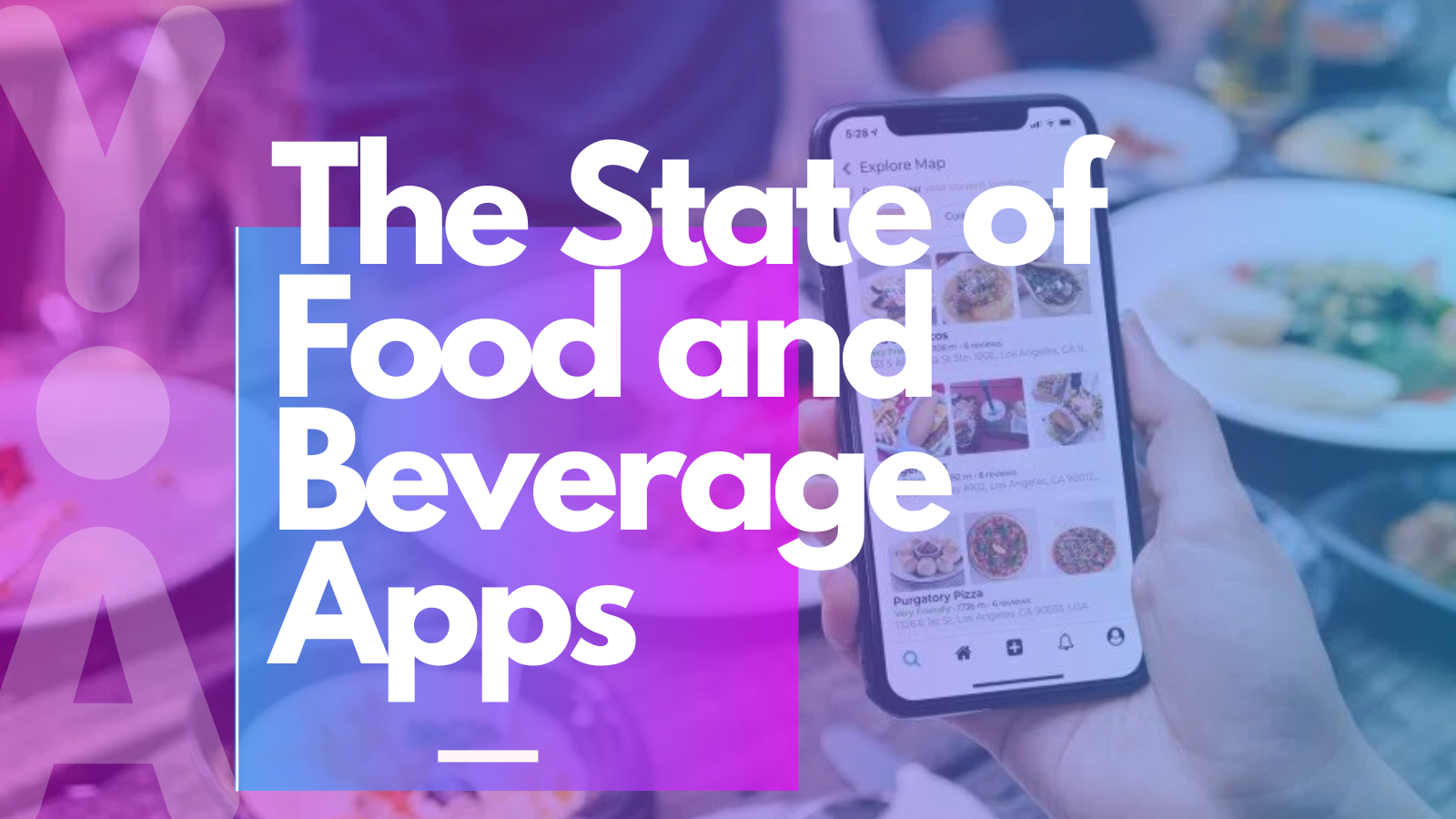Food delivery has become the norm in the restaurant industry and reached new heights while Americans were sheltered in their home early in the COVID pandemic. In fact, downloads of food and beverage apps hit 1.7 billion in March 2022, up nearly 10% from 2021. Global user sessions in food and drink apps were measured at 37 billion in Q4 2020 and by Q4 2021 they had risen to 62 billion – a growth of around 69%.
With the growing popularity of these types of apps, competition has grown as well with a few key players taking a large majority of the market share. More than 80% of the US food delivery app market is run by DoorDash and Uber Eats, creating little room for others to enter and succeed in this delivery war.
Despite the immense growth in food delivery apps during the past few years, things do seem to be slowing down, which means even the biggest players in the space need to stay innovative and creative to keep users engaged and active on their app. Additionally, smaller food and beverage delivery apps need to assert their dominance in this consolidated space.
The Big Players
A mere few years ago GrubHub had its hand on 36% of the delivery space and DoorDash had a mere 16% versus the 53% they own now. Now, the market is run by only two major names, which changes the way marketers need to look at their delivery app strategies.

Source: McKinsey & Company
The success of DoorDash and Uber Eats come at the expense of other smaller players, which have seen their market shares decrease substantially. However, while their competition is still growing at a more rapid pace, other smaller delivery apps have seen increases in their annual revenue due to the increasing size of the overall market.
As the delivery app market matures and grows, control is being consolidated in the hands of a smaller number of companies.
Changes in the Food and Beverage App Space
Although big players in the food and beverage app space have continued to increase their delivery revenue in 2022, their growth rates have slowed tremendously.
Total orders for all food delivery apps grew 11% year over year from April to June 2022, which was the slowest quarterly expansion since the pandemic began. Delivery spending also rose at its slowest quarterly pace in two years in the three months through June. Instacart, cited “market turbulence,” in June of 2022 and cut its valuation by 40% while slowing hiring. Even publicly traded companies such as DoorDash and Deliveroo have seen their stock prices fluctuate wildly over the past year.
The downturn for these companies is most likely to continue as Americans become increasingly budget-conscious amid rising inflation and higher fuel costs. The reduced growth can also be attributed to the return of in-person dining in the last year. According to Technomic, the portion of meals consumed at in-person dining establishments hit a post-pandemic high in the first quarter of 2022, while the share of food-app deliveries fell to its lowest level since the fourth quarter of 2020. The decline in app usage can also be attributed to users avoidance to paying fees, tips and higher food prices.
Staying Competitive in the Food and Beverage App Space
With big players such as DoorDash and Uber Eats taking the majority of the delivery app market and consumers slowing their spending, it is more important than ever for apps to stay competitive and creative in their retargeting and retention strategies. Holding onto your valuable users and making sure they stay engaged is an integral part of winning more space in the ever-competitive delivery market.
Run Promotions
Offering discounts or free meals is an excellent way to regain dropped off users and to boost excitement for using the app. A great example of this working is with Grubhub. Grubhub has struggled to adapt to a post-pandemic fall in demand and increased competition from rivals such as DoorDash and Uber Eats. Recently, however, they launched a free-lunch promotion and saw a gain of 200,000 new users.
Running promotions are great for building trust among your users because they reinforce positive sentiment. Food and beverage delivery apps don’t necessarily need to promote free items but giving discounts for loyal users or those who have hit a certain amount of spending during a given time can encourage consistency among users and provide a positive brand association through an understood “appreciation” of users by “giving back” to them. With the number of options that users have to sort through when choosing where to order from, apps can stand out from the competition with promotions and loyalty offers. After all, everyone likes receiving discounts and other incentives!
Millennial Focus
The generation of millennials is substantially changing the course of the food delivery business. Millennials spend 38% less on home cooking and 73% put in more than 40 hours of work per week. Additionally, around 60% of families today have two working parents, which means millennials have less free time to prepare meals every day and are increasingly turning to food delivery.
With this in mind, food delivery app marketers should target millennials, as they are the most active consumers of the food industry. Try running messaging that sympathizes with the long hours and work-from-home life that most millennials are still participating in, while playing with current slang or phrasing relatable to this age group. Make sure that your users know you are here for them and are willing to make their lives easier by providing them with quick and easy access to groceries and delicious meals, in relatable verbiage that they would appreciate.
Grocery and Alcohol Inclusion
Food and beverage delivery apps aiming for success in this industry should not limit their focus to one area of the ever-growing delivery ecosystem. Apps such as Uber and DoorDash are focusing more on delivering groceries and alcohol in addition to meals in order to increase revenue.
DoorDash has partnered with Albertsons for 30 minute grocery delivery which — until recently — was a sector of the grocery delivery business dominated by Instacart. Creating a one-stop-shop for consumers to get all their necessities limits the need for users to go searching for other apps to get their supplies. Try partnering with local grocery store chains to help your users conveniently and quickly get access to more than just restaurants!
Takeaways of The Current State of Food and Beverage Apps
Food and beverage app delivery is still immensely popular with downloads hitting 1.7 billion in March 2022, up nearly 10% from 2021. Additionally, more than 80% of the US food delivery app market is run by DoorDash and Uber Eats, creating little room for others to enter and succeed in this delivery war. However, growth in this sector is slowing, indicating the need for innovation and creativity now more than ever.
Here are some key strategies to stay relevant in this competitive environment -
- Run Promotions: Offering discounts or free meals is an excellent way to regain dropped off users, with Grubhub’s free-lunch promotion as a perfect example. After they launched this promotion, Grubhub saw a gain of 200,000 new users. Promotions such as these are great for building trust among your users!
- Millennial Focus: Millennials are substantially changing the course of the food delivery business. They spend 38% less on home cooking and 73% put in more than 40 hours of work per week – meaning that delivery is a perfect option for them. Because of this, app marketers should work on targeting their ads to millennials, as they are the most active consumers of the food industry.
- Grocery and Alcohol Inclusion: Food and beverage delivery apps need to work on creating a one-stop-shop for consumers. This means that these apps shouldn’t limit themselves to just delivering from restaurants but also expand to work with grocery stores and liquor stores.
Interested in learning more about how to win the food delivery war? Chat with one of our expert marketers here!

